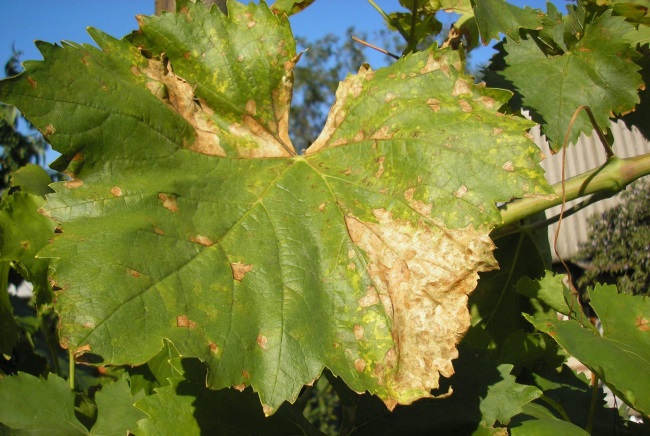
If the leaves on the grape bush began to dry, turn yellow and fall off, then this is a sure sign that the plant is in a depressed state and it urgently needs to be saved.
First of all, it is necessary to establish the cause of the ailment, because a correctly diagnosed diagnosis will help to improve the grape plant in a short time.
Content
Why do the leaves dry on grapes
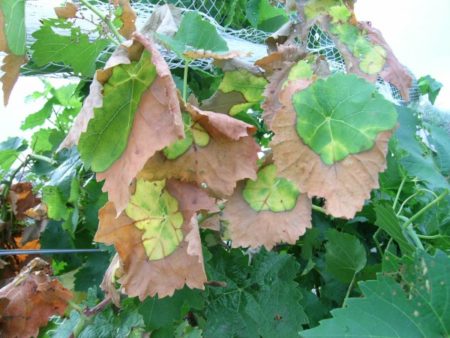
Grape - capricious culture. The slightest change in weather or environmental conditions will certainly affect the development of the bush. There are many reasons why leaves may dry out, turn yellow, or blacken. However, changes in their structure can be caused by various factors.
For what reason do vine leaves dry:
- diseases (both infectious and non-infectious);
- exposure to harmful insects;
- lack of moisture in the soil;
- damage to the roots;
- cultivation of a variety not suitable for the region;
- insufficient amount of fertilizer applied;
- violation of growing conditions.
Lack of moisture
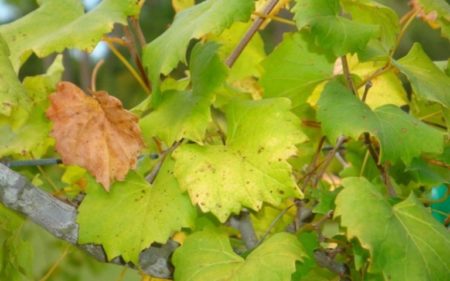
Grape - The plant is southern, but it can not grow in conditions of constant drought, without enough moisture. The root system of an adult grape bush goes deep underground, reaching a length of 80-100 centimeters. This means that to this very depth of soil should be well moistened. If the roots do not receive a sufficient amount of water, then they will cease to fully nourish the ground part of the plant, which immediately affects the juicy green leaf plates. Leaves, in the vessels of which there will be no moisture, first dry, and then fall off.
Solution. If the first symptoms appear, then first you need to immediately water the shrub, and later adjust the irrigation schedule. A moisture-loving plant must be watered at least twice a month, and in hot periods it is necessary to increase the number of irrigation, at least up to four times a month. Before flowering and during the ripening of the harvest, grapes are watered less often so as not to cause cracking of the berries. Humidify the soil to a depth of 80 centimeters. Water consumption per adult plant is 20 liters. It is recommended to water the vineyard under the root along shallow grooves made along the perimeter of the base of the plant. So that moisture does not stagnate, the earth must be loosened after irrigation. You can keep the land moist as long as possible by mulching the ground under the plants.
Mineral starvation
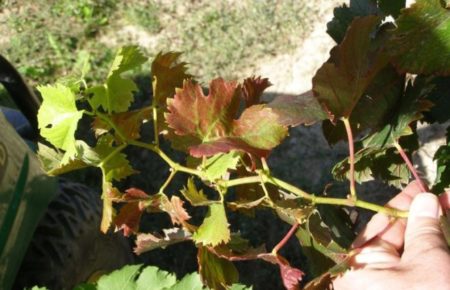
Grape bush during the growing season requires a lot of minerals. If potassium, phosphorus, nitrogen, or such trace elements as zinc, boron, magnesium and others are not enough for him, then the plant will slow down its development, the leaves will begin to curl, darken and dry out, which will inevitably lead to their subsidence. The grapes dry leaves at the very bottom of the bush - most likely, this indicates a lack of nitrogen. This condition can be observed in the middle of summer. And when the edges of the leaves are bent outward, this can indicate a lack of potassium. Phosphorus starvation leads to darkening of leaf veins. If you do not take action, the leaves will fade.
Solution. Banal top dressing with the missing element will help revive the vine bush, saturate the leaves with nutrients.If the reason for the yellowing and drying of the leaves lies in the lack of nitrogen, then it is necessary to feed the grapes with mullein or bird droppings diluted in water. You can use mineral supplements, such as urea or ammonium nitrate. Potassium may not be enough for the plant at the time of flowering and fruit setting. During this period, it is recommended to carry out unscheduled spraying with potassium sulfate or treat the bushes with a solution based on iodine, baking soda and water. When the leaves are darkened, when there is confidence that the plant lacks phosphorus, superphosphate dissolved in water will help saturate the grapes quickly.
Violation of growing conditions
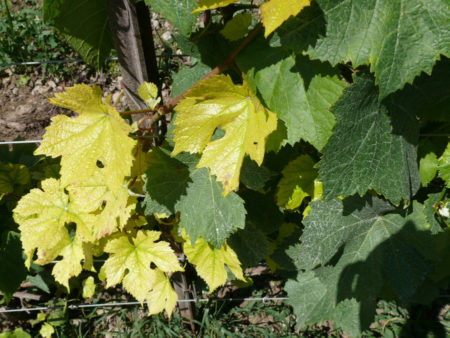
If the plant "lives" in uncomfortable conditions, then it quickly ceases to develop and does not bear fruit well. Its foliage dries, the fruits wither, the flowers fall en masse. The health of grapes is affected by weather factors, such as a lack of light. In this case, the leaves first become light, and then dry. Negatively affects the sheet plate temperature extremes and excessive humidity.
Solution. Drying leaves associated with improper agricultural technology is the easiest way to cure. It is enough to adjust the conditions for growing the culture, and in a few days the leaves will again become bright green, juicy. Since the grapes are deteriorating without enough sunlight, it must be transplanted to the sunniest place in the garden. If it grows in a greenhouse, then it is necessary to illuminate it with the help of phytolamps. Grapes are demanding on watering, but do not tolerate excessive moisture. And not only soil, but also air. With frequent rainfall, experienced summer residents recommend installing an awning over the vineyard. When growing greenhouses, it is important to carry out constant ventilation, keeping the air humidity within 60%. A sharp temperature drop affects the vine negatively. Therefore, with possible frosts, it is recommended to mulch the earth so that the roots are protected from the effects of subzero temperature. During sultry days and a rise in temperature beyond +25 degrees, the grape bush should be sprayed with water and shaded from the scorching sun.
Disease
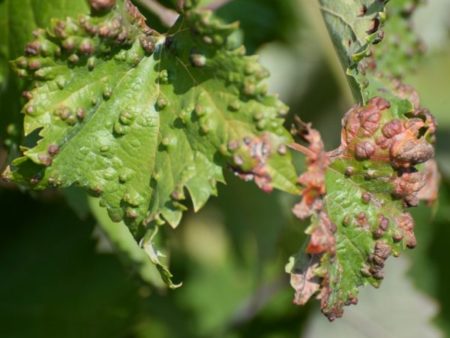
Absolute majority diseases immediately reflected on the appearance of the foliage - it turns yellow, and then dries out. If you see this sight in your vineyard, it means that the plant has overtaken some kind of disease. It can be infectious and non-infectious (i.e. not contagious). If in time to determine the nature of the infection, then the vineyard can be saved and get a plentiful harvest. In addition to spraying with fungicides, it is also necessary to follow agrotechnical recommendations that will allow keeping the garden culture healthy for many years.
Diseases causing drying of the leaves and methods for their treatment:
Verticillosis (verticillosis wilt). Fungal root disease, which, being struck by the fungus, cease to fully nourish the leaves and they begin to lose their juiciness, become clumsy, and dry out. If the pathogen is not removed from the soil, the plant may die in two seasons.
Treatment: the disease can be treated only at an early stage, then the plant will not be able to save. When a few foci of sporulation appear, the bushes are repeatedly treated with Fundazol with a treatment interval of 10-14 days.
Mildew (downy mildew). Fungal spores are localized on the upper side of the leaf in the form of white “shaggy” spots, which turn black over time, turning the leaf plate into a dried stub. Berries and flowers also dry and fall.
Treatment: without intervention, the disease progresses very quickly, moving from bush to bush, the fungus can affect all garden plantings. Systematic spraying with complex fungicides - Antracol, Kuproksat, Delan will help to muffle the infection.At the first signs of the disease, you need to immediately thoroughly treat the vines with the contact preparation Hom, which will block the path of the fungus and it will not penetrate deep into the plant tissue. It copes well with downy mildew, time-tested 1% Bordeaux liquid, preparations Tsineb, Kuprozan.
Chlorosis. The disease develops with a lack of iron in the soil. Most often, chlorosis is observed on carbonate, dense soils, where nutrients are poorly absorbed. With chlorosis, the formation of chlorophyll is disrupted. That's why grapes turn yellow leaves, and then fall off en masse. If the disease is not treated, then the vine will stop growing and die.
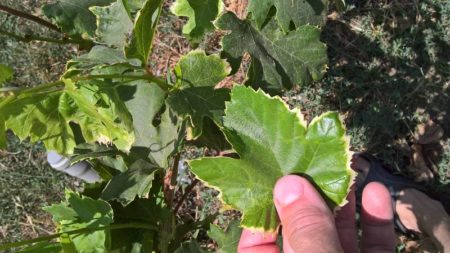
Treatment: the introduction into the soil of iron-containing preparations, such as Antichlorosin, Mikom-reakom. Site treatment is carried out once a week until all symptoms of the disease disappear. The bushes are sprayed with iron sulfate (50 grams per bucket of water) every 4-5 days until they acquire a green shine.
Gray rot. Infection develops in a moist, warm environment. The fungal pathogen causes rotting of the affected areas. Damaged, they gradually twist, dry and fall off the bush.
Treatment: if disease already proved itself, then fungicidal preparations (Fundazol, Kaptan, Topsin M, Triadimefon, Topaz) are used in the fight against it. With a weak infection, the bushes are treated with an aqueous solution of potassium iodide (2 grams of the substance per 10 liters of water), copper sulfate (15 grams per bucket of water). As protective agents Mikal, Volkan, Antrakol act.
Black spotting. The fungus that has fallen on the leaves is localized primarily on the upper layers of plant cells, affecting them. From this, the leaf plate is discolored, numerous small brown spots appear on it, which quickly increase in size, burning the sheet. It becomes clumsy, holes of various sizes appear on it. Affected leaves fall off the bush. The disease can concentrate on one plant for 4-5 years.
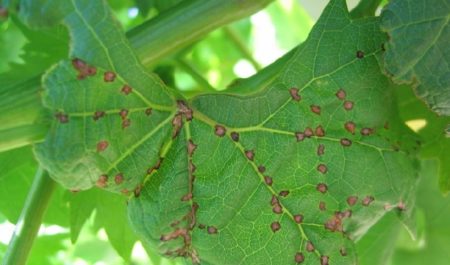
Treatment: since the disease is "long-playing", you can notice it when it has not yet completely mastered the bush. Initially, you need to remove all the diseased shoots, tear off the bulging leaves. After that, the bush is treated with fungicide (Abiga-Peak, Kuproksat, Bordeaux liquid). One treatment will not cure the plant immediately, this will require many years of spraying, a series of preventive measures to prevent the appearance of fungus. For example, it is necessary to ensure that the bushes are well tied and the leaves do not touch the ground. It is also important to feed micronutrients on time, in particular to nourish grapes with zinc and boron, which increase the plant's immunity to infectious diseases.
Alternariosis. A disease of a hot climate. Leaves dry at the edges, covered with yellow ugly spots, then fall off.
Treatment: to combat the disease, the bushes are sprayed with mullein infusion, manganese solution. Of folk remedies, processing of grapes with whey is popular, in which iodine is also added. Of the chemicals, the drug Trichodermin is considered effective. More powerful means - Skor, Quadrice, Rapid Gold.
Dangerous pests
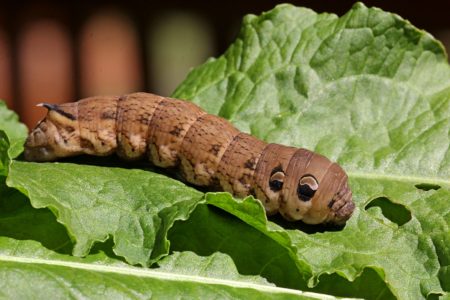
Almost all insects that feed on plant sap cause a diseased leaf condition.Especially negative is the effect of caterpillars, leafworms, aphids, spider beetles and other microscopic living creatures. So the twisting and dying of the leaves occurs when the larvae of the drooling foam get on the plant. Their products of vital activity (foamy discharge) cause a blockage of growth processes in the leaf, which is why it gradually dies. The most common guest in the garden is the leaflet. She eats exclusively leaves, depriving them of vitality. A rapidly growing colony of spider mites can kill a vineyard in a few weeks. A cobweb made of the finest mesh wraps leaves and stems, causing thinning of the plates and their quick death.
Solution: according to some summer residents, it is easier to deal with pests than with diseases. Various traps and baits are used against them, which significantly reduce the number of insects. Most often, folk methods are used in the fight against various kinds of animals. So, against caterpillars, ticks, aphids and other pests, spraying plants with infusions of odorous herbs (yarrow, marigolds, dandelion, garlic, onion), dusting the area under the bushes with ash or spraying the bushes with an ash solution. If the number of the pest has reached catastrophic proportions, then chemical means - insecticides are used. Against ticks, leafworms, thrips and aphids, contact-intestinal preparations Akarin, Actara, Actellik, Bi-58, Inta-virus, Confidor, Tanrek and others help. These drugs are used according to the instructions not only for the destruction of already propagated insects, but also as a preventive measure.
Root damage
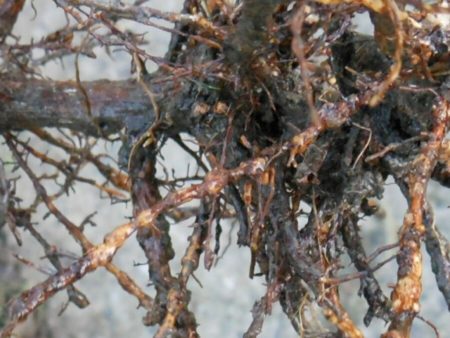
If the aerial part of the plant has acquired an unhealthy appearance, then perhaps the problem lies in the roots, or rather, their damage. The fact is that part of the root system of grapes is in a horizontal plane close to the surface. With improper loosening, fertilizing, digging the site, root shoots can easily be damaged. This problem is especially relevant for young bushes, which slow down growth even with minor damage to the roots. Adult plants more easily tolerate the infliction of wounds, if you injure one root, then this will not affect the general condition of the bush.
The roots can be damaged due to unsuccessful shelter of the plant for the winter. If the winter was cold and snowless, then the uncovered root system can freeze. In summer, various rodents can ruin the roots - moles, mice, and arthropods.
Solution: if the roots are not touched very much, and we are talking about a young grape bush, then you can dig it up, remove the affected areas of the roots. Then soak in manganese solution or in any antifungal solution. Before planting, the roots are kept in a growth stimulator - this will contribute to the rapid growth of new radicular shoots. Landing is carried out in loose fertile and moist soil.
If the roots are damaged in an adult bush, then the area where the roots lie can be shed with manganese solution or any antiseptic. It is better not to overfill the soil during the healing of root wounds in order to prevent decay.
Commotion
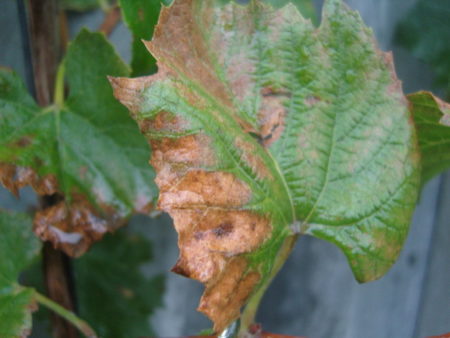
The causative agents of infectious diseases can be transported over long distances using wind, rainfall, contaminated equipment, animals and birds. If one plant fell ill in the garden, then in most cases the remaining ones become infected during the first week.
Solution: It is important to regularly inspect all plants in the garden for signs of illness. If the affected bush is found, it must be removed as soon as possible from the site - this will save time and effort in trying to return the plant to a healthy look. It is wiser to sacrifice one bush than to risk the health of all garden plantings.
Wrong variety selection
Often, beginners in horticulture unknowingly plant varieties not suitable for the climate of a particular region grape. If the variety is recommended for cultivation in the southern regions, then it will not be able to fully grow and develop in the north of the country. And vice versa. A plant that does not have resistance to certain climatic conditions grows weakened and unprotected against diseases and pests. Such grapes will quickly deteriorate - the leaves will dry out, and there will be few berries, and they will not taste good.
Solution: When choosing grapes for your summer cottage, do not rely on the beautiful picture on the label, but on the description and characteristics of the variety. The manufacturer indicates in what conditions it is better to grow a particular culture. If it is indicated that grapes are recommended for growing in a greenhouse, then in open ground one should not expect enchanting results from it. For the central region of the country and the North, it is preferable to choose frost-resistant, disease-resistant early grape varieties. For the south, varieties that withstand prolonged drought, lack of water and fertility soil are suitable. If you provide the plant with comfortable conditions, you can avoid many health problems of grapes.
Prevention
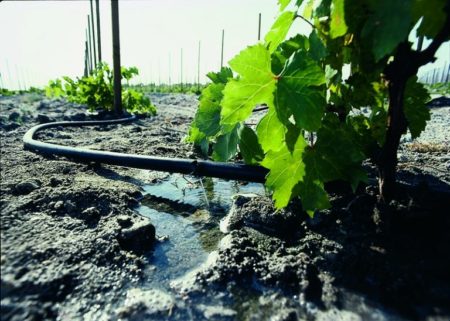
Such an ailment as the drying of the leaves will bypass the vineyard, if correctly carried out preventive measures aimed at maintaining the plant in a healthy state.
The basics of prevention:
- Break the vineyard only on fertile light soils. This will protect against chlorosis.
- Do not fertilize dense soils with fresh manure and bird droppings, as this can lead to chlorosis.
- Regular spraying of bushes with fungicides (Ridomil Gold, Kuproksat) will help to avoid the appearance of fungus on plants.
- Feed strictly according to the schedule, as the plants react sharply to both the lack of fertilizers and their oversupply.
- Watch out for watering. Do not water the soil.
- In autumn, thoroughly clean the area of plant debris, and dig up the ground.
Conclusion
All the above reasons why the leaves dry grape, help to understand what to do and how to treat the crop to save the crop. The struggle for the health of the grape bush is an everyday work that requires the viticulturist both experience and knowledge. The cultivation of resistant to fungal diseases varieties such as Rapture, Lydia and others will help to get by with little blood. But even these varieties require the prevention of diseases, so you should always be vigilant and attentive to your grapes, regardless of which variety grows in your garden.

 Non-covering winter-hardy grape varieties for Moscow region
Non-covering winter-hardy grape varieties for Moscow region How to keep the vine in winter
How to keep the vine in winter When can I transfer grapes to another place in the fall
When can I transfer grapes to another place in the fall How to cover and prepare grapes for the winter in the suburbs
How to cover and prepare grapes for the winter in the suburbs